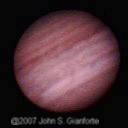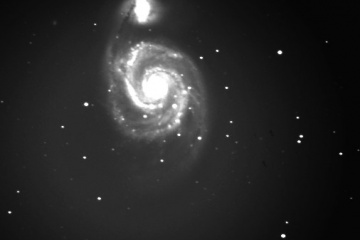The summer of 2008 will provide many hours of observing pleasure for those heading outdoors after sunset. While it is true that we’re losing Mars and Saturn as they sink toward the southwestern horizon by the time darkness falls, but on the other end of the sky—in the southeast a new “star†is rising—only, it isn’t a star, it is the giant planet Jupiter. By the time evening twilight rolls ends, Jupiter will be easily visible in the southeastern sky. It will appear as a very bright, yellowish star that does not twinkle. If you can hold your 7 X 50 mm binoculars steady, you might be able to make out up to four small points of light on either side of the giant planet. These are the Galilean satellites—moons of Jupiter discovered by Galileo in late 1609. Jupiter’s gravity holds these massive moons tightly with its strong gravitational field. So these points of light orbit the planet rapidly. In only a matter of an hour or so you will be able to detect a shift in their position relative to one another and to Jupiter itself.
 If you have a small telescope, get it out on one of these fine summer nights. For even a small telescope will reveal a wealth of detail. Not only will you be able to get a better view of the four Galilean satellites, but you will also be able to clearly see cloud belts in Jupiter’s atmosphere. Imagine that, observing clouds in the atmosphere of a world over 394 million miles from Earth! And, Jupiter will look a little different each night—its moons will appear to dance around Jupiter. Some nights you may see two on either side of Jupiter, then a few hours later or may be the next night you’ll see three lined up on one side and one on the opposite side all by itself. This dance of the Galilean satellites kept Galileo busy at his small telescope from January through April of 1610, when it first dawned on him that these four small points of light were actually orbiting Jupiter. Those observations of nearly 400 years ago changed our concept of the solar system and the universe, forever.
If you have a small telescope, get it out on one of these fine summer nights. For even a small telescope will reveal a wealth of detail. Not only will you be able to get a better view of the four Galilean satellites, but you will also be able to clearly see cloud belts in Jupiter’s atmosphere. Imagine that, observing clouds in the atmosphere of a world over 394 million miles from Earth! And, Jupiter will look a little different each night—its moons will appear to dance around Jupiter. Some nights you may see two on either side of Jupiter, then a few hours later or may be the next night you’ll see three lined up on one side and one on the opposite side all by itself. This dance of the Galilean satellites kept Galileo busy at his small telescope from January through April of 1610, when it first dawned on him that these four small points of light were actually orbiting Jupiter. Those observations of nearly 400 years ago changed our concept of the solar system and the universe, forever.
Jupiter is currently residing within the constellation Sagittarius, the archer, which is right in the heart of the summer Milky Way for northern hemisphere observers. On these summer nights, Sagittarius is just about due south around 10:30 PM local time. In that part of the sky Jupiter will be by far, the brightest object around and very tough to mistake it for anything else.
As you find yourself out late on these warm summer nights don’t resist the urge to look up and let your eyes wander through the sky. As you do this, you may notice three bright stars high overhead that form a large triangle around 11 PM or so. These three stars from brightest to faintest are Vega, Altair, and Deneb. Each star is one of the brightest in the entire sky—and each one is the brightest star in a different constellation.
Vega, the brightest of the three is the alpha star of the constellation Lyra, the harp. Altair the second brightest of the three is the brightest star in Aquila, the eagle. And finally, Deneb the dimmest of the triangle is the brightest star in Cygnus, the swan. These three signpost stars of the summer sky, for northern hemisphere observers, are collectively know and the Summer Triangle. It is one of best know asterisms in the sky. So be on the lookout for these familiar luminaries of the night sky. They make great steppingstones to learn other stars and constellations of the July and August skies.
One more sight of the summer sky I should tell you about. Around August 11 and 12 be on the alert for members of the Perseid meteor shower. This prominent and reliable, annual meteor shower peaks on August 12. You might know these bright streaks of light that slice open the night sky as shooting stars. But this is a misnomer because these fast-moving streaks of light have not a thing to do with stars and everything to do with tiny specs of interplanetary dust—most no bigger than a grain of sand. As these small bits of dust and rock streak through our atmosphere at speeds of 30 miles per second, they heat up very quickly and vaporize in a flash of light. We call this flash of light a meteor.
If you venture out after dark on the nights surrounding August 11 and 12 and look toward the northeastern sky, if you’re patient, you will no doubt see members of the Perseid meteor shower. Your best bet to see some of the celestial fireworks is to get comfortable in a lounge chair facing the northeast and just wait. Meteor watching is always more fun if done with company. And, while you’re at it pop up some popcorn, sit back and enjoy the show. Hopefully your skies will be clear for this summer favorite! Happy hunting.
Got questions about astronomy? Interested in buying a new telescope or binoculars? Are you ready to combine your vacation with an astronomical adventure? Send in your questions to theskyguy at john.gianforte@unh.edu and I’ll do my best to answer your question. You can click on the email link at the bottom of the page.
